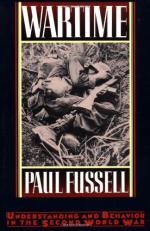
|
| Name: _________________________ | Period: ___________________ |
This test consists of 15 multiple choice questions and 5 short answer questions.
Multiple Choice Questions
1. At the beginning of World War II, aerial combat was regarded as exemplifying what obsolescent ideal?
(a) Chivalry.
(b) Single combat.
(c) Dueling.
(d) Honor.
2. The presentation of the war by state and public media is best described as which of the following?
(a) Realistic.
(b) Gruesome.
(c) Sanitized.
(d) Aggrandizing.
3. The author suggests that before the outbreak of war, the American military was prepared for what type of performance?
(a) Extended duty.
(b) Heavy duty.
(c) Rapid deployment.
(d) Light duty.
4. Soldiers were often not given what type of information?
(a) Their Captain's name.
(b) Their orders.
(c) Their location.
(d) Their division.
5. Throughout Chapter 6, the author describes enlisted men as being which of the following?
(a) Poor.
(b) Ignorant.
(c) Faceless.
(d) Pitiable.
6. Heavy drinking and womanizing caused problems for the army in what area?
(a) Health.
(b) Morale.
(c) Organization.
(d) Discipline.
7. According to the author, what was the typical age of a soldier for the allies in WWII?
(a) Twenty-two.
(b) Nineteen.
(c) Twenty-one.
(d) Twenty.
8. According to the author, most of the well-known novels about WWII are really about what?
(a) Petty hazing.
(b) Boredom.
(c) Officers.
(d) Discipline.
9. What is unusual about the friendly-fire incident discussed in Chapter 2 and illustrated on page 18?
(a) It is still denied by military officials to this day.
(b) It was covered up.
(c) The bombs were all duds.
(d) No one was hurt.
10. The drinking among servicemen when alcohol was freely available would best be described as which of the following?
(a) Jovial.
(b) Reasonable.
(c) Social.
(d) Excessive.
11. What drink did American troops generally prefer?
(a) Whiskey.
(b) Bourban.
(c) Gin.
(d) Rum.
12. The use of meaningless and tedious tasks as hazing would best be described as which of the following?
(a) Common.
(b) Rare.
(c) Constant.
(d) Uncommon.
13. Which of the following is not a concept that the iconic pre-war image in Chapter 1 is said to convey?
(a) Military strength.
(b) Mobility.
(c) Vitality.
(d) Military readiness.
14. The author states that most of the weapons issued to American armed forces suffered from what problems?
(a) They were obsolete.
(b) They were too expensive.
(c) They were poorly made.
(d) They were issued in insufficient numbers.
15. The rumor about German sympathizers conveying intelligence to the enemy suggested that they were relaying what type of information?
(a) Artillery locations.
(b) Troop movements.
(c) Troop locations.
(d) Air strike flight plans.
Short Answer Questions
1. The author suggests that combat training replaces what other activity typical for young men?
2. Which of the following is NOT one of the ways that most contemporaneous war histories depicted military blunders?
3. The author suggests that most people prefer to feel that their lives have what?
4. Compared with the enlisted men, officers would best be described as which of the following?
5. Most proponents of precision bombing suggested that it be used to destroy what enemy targets?
|
This section contains 441 words (approx. 2 pages at 300 words per page) |

|




